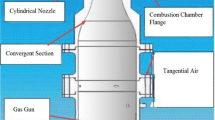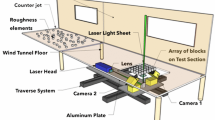Abstract
Stereoscopic particle image velocimetry measurements were made in a wind tunnel using a prototype waterjet model. The main wind tunnel provided the vehicle velocity and a secondary wind tunnel was set up as the waterjet propulsion model. Pressure distributions along the ramp and lip sides inside the duct were measured for three jet velocity to vehicle velocity ratios. Three-dimensional velocity fields were obtained at the intake entrance and the nozzle exit of the waterjet system. The flow into the duct was faster in the lip region than on the ramp side. Because of the variation in intake geometry from a rectangular to a circular section and because of the sudden curvature change on the lip side, a pair of counter-rotating vortices was observed in the mean velocity field at the nozzle exit. In addition, the turbulent kinetic energy correlated with the vortex pair was stronger on the lip side than in other areas. Dominant large-scale structures were extracted by using a snapshot proper orthogonal decomposition analysis. It was found that most of the turbulent kinetic energy was attributed to at least three vortices near the nozzle exit. This detailed three-dimensional velocity field will be useful for the verification of CFD simulations applied to the waterjet system.
Similar content being viewed by others
References
Svensson R (1991) Water-jet propulsion of high-speed craft. Conference on High-Speed Marine Transportation IMAS 91, Sydney, November 11–13, pp 147–157
SM Roy (1994) The evolution of the modern waterjet marine propulsion unit International Symposium on Waterjet Propulsion RINA London
Choi GI, Ahn YW (2002) The generation of waterjet inlet geometry using NURBS. The Second PNU International Colloquium on Waterjets, Busan, Korea, December 11, pp 105–110
Bulten NWH, Verbeek R (2003) Design of optimal inlet duct geometry based on vessel operational profile. International Conference on Fast Sea Transportation, FAST 2003, Vol 1, Ischia, Italy, October 7–10, pp 35–40
Park WG, Yun HS, Chun HH, Kim MC (2002) Numerical analysis of intake flow of waterjet pump. The Second PNU International Colloquium on Waterjets, Busan, Korea, December 11, pp 73–91
K Alexander H Coop T van Terwisga (1994) ArticleTitleWaterjet–hull interaction: recent experimental results SNAME Trans 102 87–105
JL Roberts GJ Walker (1998) Boundary layer ingestion effects in flush waterjet intakes International Conference on Waterjet Propulsion RINA Amsterdam
JL Lumley (1967) The structure of inhomogeneous turbulent flow AM Yaglom VI Tatarski (Eds) Atmospheric turbulence and wave propagation Nauko Moscow 166–178
L Sirovich (1987) ArticleTitleTurbulence and the dynamics of coherent structures part I: coherent structures Q Appl Math 5 561–571 Occurrence Handle910462
KC Kim SY Yoon (2000) ArticleTitlePIV measurements of the flow and turbulent characteristics of a round jet in crossflow J Visualiz 3 IssueID2 157–164 Occurrence Handle1816558 Occurrence Handle10.1007/BF03182408
Author information
Authors and Affiliations
Corresponding author
About this article
Cite this article
Jung, K., Kim, K., Yoon, S. et al. Investigation of turbulent flows in a waterjet intake duct using stereoscopic PIV measurements. J Mar Sci Technol 11, 270–278 (2006). https://doi.org/10.1007/s00773-006-0236-3
Received:
Accepted:
Published:
Issue Date:
DOI: https://doi.org/10.1007/s00773-006-0236-3




